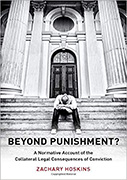Beyond Punishment: A Normative Account Of The Collateral Legal Consequences Of Conviction

Author: Zachary Hoskins
Publisher: Oxford, UK: Oxford University Press, 2019. 264p.
Reviewer: Douglas Husak | July 2019
Legal theorists have increasingly called attention to the fact that the “formal” or “official” punishment expressed in a sentence does not begin to exhaust the deleterious consequences visited on offenders as a result of their criminal conviction. Offenders are subject to a host of additional formal and informal measures, some of which are more onerous than the punishment itself. No commentator who thinks seriously about the criminal law is unaware of the existence or severity of these collateral consequences. In the event a legal scholar remains uninformed, comprehensive websites of the various collateral consequences imposed throughout the several jurisdictions in the United States are available. For example, see: (https://niccc.csgjusticecenter.org/).
Many students of the criminal law are able to describe these consequences. They extend primarily to such matters as employment, government housing, and state benefits. Zachary Hoskins, however, is the first sophisticated philosopher to provide a conceptual and normative framework in which the legitimacy of these collateral consequences can be evaluated. The questions to be answered include: Are these collateral measures properly categorized as punishments, or should we categorize them as something else—as, say, devices to protect the public? The answer to this question is important for a variety of practical and theoretical purposes, but we have no hope of resolving it without invoking a definition of punishment. According to Hoskins, a punishment is an intentionally imposed burden that expresses condemnation of the offender’s wrongdoing. Applying this definition yields the result that some collateral consequences are properly regraded as punishments, whereas others are better conceptualized as civil measures. No “one-size-fits-all” analysis is defensible. Instead, we have little choice but to tolerate messiness, imprecision, and borderline cases.
The normative component of Hoskins’ analysis evaluates the justifiability of a given collateral consequence from each of these two perspectives. If conceptualized as a mode of punishment, it must conform to the principles we use to assess punitive measures. It must, for example, satisfy the demands of proportionality. Moreover, acceptable modes of punishment must treat offenders with respect, and not exhibit contempt that hinders opportunities for offenders to change their lives in a positive direction. If conceptualized as a civil measure, it must serve a morally compelling interest, not generate offsetting negative consequences, and represent the least burdensome alternative. Hoskins applies these criteria to conclude that few collateral consequences should survive as either punitive or civil measures.
One welcome feature of Hoskins’ approach is his explicit realization that the failure to categorize a given collateral consequence as a punishment does not exhaust the important normative questions we should raise about it. Coercive state power is exercised in a multitude of forms, and philosophers of law should not be obsessed with the determination of whether a given exercise is or is not punitive. Political and legal philosophers should expend their horizons and examine the justifiability of state-sanctioned harsh treatment generally. The case of collateral consequences, as analyzed by Hoskins, provides an excellent occasion to do so.
Although Hoskins is sensible and thorough throughout, the final section is the most original part of his book. Here he defends two relatively novel claims. First, as a precondition for a guilty plea to be voluntary and effective, a given defendant must be informed not only of the so-called “direct consequences” of conviction — the formal sentence itself — but also of the vast array of collateral consequences which may follow from his plea. Moreover, the responsibility to ensure that defendants are informed of these potential consequences should fall on prosecutors rather than on defense counsel. Among other advantages, Hoskins argues that this assignment of responsibility is likely to have the salutary effect of inducing legislators to limit the number and scope of the collateral consequences that exist in the first place. Second, Hoskins alleges that the impact of collateral consequences constitutes one of the worries about the phenomenon of overcriminalization. If too much criminal law is problematic largely because it produces too much punishment, it is equally true that it has produced too many collateral consequences. Hoskins contends that legislators must take into account the harms these collateral consequences inflict in their deliberations about whether a given kind of conduct should be criminalized at all. Criminal theorists have rarely connected their interest in collateral consequences with these important issues. Hoskins’ treatment deserves credit for encouraging them to make these connections.
My only reservation is that Hoskins might have enlarged his normative horizon even further. He is certainly correct that philosophers should be willing to evaluate a burdensome legal measure even if it does not amount to a punishment. States use many mechanisms to coerce, and punishment is only the most obvious. Once we expand our normative focus, however, why restrict our gaze to the measures imposed by the state? Non-state actors also inflict a variety of negative consequences on offenders, and these effects should be evaluated as well. Hoskins, of course, is aware that many deleterious collateral consequences are “informal,” that is, imposed by non-state actors. Having noted the existence of these measures, however, he mostly puts them aside. But the justifiability of many of these devices becomes more difficult to contest when they result from private decisions by non-state actors. Consider a few examples. Suppose a landlord has many potential tenants from whom to choose for an apartment. Is she acting wrongly if she disqualifies a prospective tenant because he has multiple convictions for drug distribution? Or suppose a parent needs to find a baby-sitter for her children. Is she acting impermissibly if she fails to hire someone who has been arrested for child abuse? Or suppose an employer interviews applicants for a responsible position. Is her decision morally problematic because she is reluctant to hire someone who has a record of stealing from previous employers? We make efforts to prevent discrimination against tenants or employees on racial or religious grounds, but should we make comparable systematic efforts to prevent discrimination based on criminal history? Even if we could do so, should we? I would wager that employers, landlords, and (especially) parents believe that they are permitted to use the criminal records of persons as a basis for their decisions. Hoskins ably explains the philosophical grounds on which we should reject the justifiability of most formal collateral consequences. When we turn our attention to informal collateral consequences, however, I suspect that most of us will become more ambivalent. Many moral and legal philosophers believe that states both have and ought to have a monopoly on the imposition of punishment. Private vigilantism is almost always condemned. In the context of collateral consequences, however, this pair of verdicts is strangely reversed. We may be willing to allow private parties to impose consequences on convicted criminals that we would readily oppose if applied by the state.
Perhaps I am criticizing Hoskins for not writing a different book. His treatment of formal collateral consequences is thorough and persuasive. Beyond Punishment is an excellent and highly readable contribution to our growing understanding of the wide array of hardships our criminal justice system visits on offenders.
Distinguished Professor of Philosophy, Rutgers University


